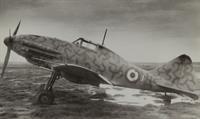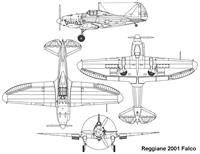.
The Reggiane Re.2001 was a development of the Re.2000 Falco I which had been rejected by the Regia Aeronautica primarily because of its unprotected fuel tanks in the wing, which were merely sealed voids between the spars, and secondly its engine. This was the main problem the Falco II set out to fix, now having a 1,175 hp (876 kW) Alfa Romeo inline engine (a more powerful and reliable license-built German DB 601) rather than a 986 hp (735 kW) Piaggio P.IX radial engine
Incorporating much of the Re.2000's fuselage structure, even retaining the entire tail unit, the Re.2001's wings were of semi-elliptical design with three spars in each wing. The initial design had conventional fuel tanks with 544 l total capacity (five tanks, one in the fuselage and the others in the wings). The armament consisted of Breda-SAFAT machine guns, with two nose-mounted 12.7 mm (up to 800 rounds) and two 7.7 mm guns in the wings, (1200 rounds total).
The new Falco II was equal to the Macchi MC.202, but the Macchi fighter, having first call on production for the Alfa Romeo R.A.1000RC.41-1a (the license built DB 601) was still produced in greater numbers. The Re.2001 was then delayed because the Regia Aeronautica insisted on the fuel tanks being placed inside the wings, which required a substantial redesign of the wing structure. The first order, amounting to 300 machines, was cut back with only 252 produced. This number included 100 Re.2001 Serie I, Serie II and Serie III with armament variations, the Reggiane Serie IV fighter-bomber and 150 Re.2001 CN Caccia Notturna, night fighter.
Due to the wing redesign coupled with production delays, the first production aircraft were finally cleared for operational use in June 1941, nearly a year behind schedule.
Along with the fighter variant, two other main variants were developed to suit specialized roles. The Re.2001 CB (Cacciabombardiere, Fighter-bomber) version produced from 1942 could carry a 100 or 250 kg (220 or 550 lb) bomb under the fuselage for the attack role. The CN (Caccia notturno, Night fighter) version was adapted with the introduction of engine exhaust-flame dampers and a 20 mm (0.79 in) Mauser MG 151/20 cannon in two gondolas, one under each wing, although many fighters retained the original armament. A total of 34 CNs were produced of the 50 ordered.

| Type |
Single seat fighter , Serie I |
| Engine |
1 Piaggio P.XI R.C.40 with a 3-bladed Piaggio-AÁscanio constant-speed propeller, dia. 3,1 m |
| Dimensions |
Length 7,99 m , height 3,2 m , span 11,0 m , wing area 20.4 m2 , |
| Weights |
Empty 2090 kg, loaded 2839 kg , max. take off weight |
| Performance |
Max. speed 530 km/h at 5300 m , cruising speed 440 km/h , range 545 km, endurance , service ceiling 11200 m , climb to 4000 m 4 min. |
| Armament |
2 12,7 mm Breda-SAFAT machine guns |
| Type |
Werk.Nr |
Registration |
History |
|
90790 |
|
JG 107 , damaged 1944.04.01 by a f 109 |
|
|
MM.7267, 393-5 |
At S. Pietro. 30.09.42 assigned to 362nd squadron. Assigned to 24th Group C.T. 19.03.43 (21.03.43) assigned to 160th Group - 393rd squadron. 20.05.43 emergency landing. Pilot Serg. Di PAoli. 08.43 at MEtato. 10.09.43 captured by Germans. |
|
|
MM 7271, 394-1 |
Lightened version for catapult test. Returns to Reggiane for modifications. 20.12.42 arrestor hook tests at Reggiane airfield. 12.02.43 other hook tests. 26.02.43 (27.02.43) assigned to 393rd (or 375th) squadron at S. Egidio airfield - Perugia. 17.03.43 assigned to M.S.A. at Perugia. Other tests are then performed. Pilot: m.llo Desideri. 07-08.06.43 second group of tests at Perugia with hook type "I" (intermediate). Pilot: Tullio De Prato. Before 08.09.43 moved to Castiglion del Lago then captured by Germans. |
|
867 |
MM.7280 |
11.06.42 used for video shooting. 29.06.42 (29.07.42) assigned to 152nd squadron. 15.02.43 assigned to 234th squadron at Venegono, poi 94-3, captured by Germans at Metato on 10.09.43. 22.01.44 arrived at Pavullo from Lucca. 19.03.44 CN version. To be dismissed and wrecked |
